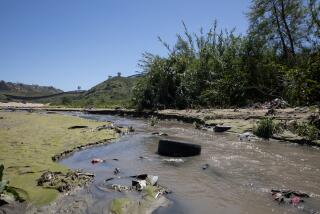More Families to Be Moved in DDT Cleanup : Pollution: During heated meeting, residents of Torrance-area neighborhood criticize the EPA for not paying more attention to potential problems.
The U.S. Environmental Protection Agency and the residents of a DDT-contaminated neighborhood near Torrance edged toward agreement on Thursday on a plan to clean up tainted soil in two back yards.
As officials prepared for a tense meeting that wound up drawing more than 200 people, EPA officials said they had decided to increase the number of families the government would temporarily relocate for the project, which was postponed this week because of the communityâs concerns.
A neighborhood environmental group had demanded that the government pay to temporarily house 17 families during the two-week excavation of two back yards on a modest block of West 204th Street. EPA officials already have moved three families to hotels but said Thursday they would raise the number to five and decide early next week whether to move the other 12 families, as the group, the Del Amo Action Committee, has requested.
âWe feel that the number of people weâve already agreed to relocate is satisfactory and is fully protective,â said Nancy Lindsay, chief of the Superfund enforcement branch at the EPAâs regional office in San Francisco.
âWhat the community is asking us is to go beyond that, to be more protective. Weâre listening because we need to build some trust and credibility with this community.â
That message came across loud and clear at Thursday nightâs public meeting, a sometimes vitriolic gathering that had been organized by the EPA. Many residents voiced anger that the agency had not paid more attention earlier to their concerns about potential health problems from chemical contamination in their neighborhood.
West 204th Street, a working-class neighborhood alongside an industrial complex, is flanked by two toxic waste sites, and some residents believe the current soil contamination problem may have migrated from one of them, a federal Superfund site where DDT was once manufactured.
EPA official John Blevins told residents at the meeting that the high levels of DDT in two back yards may be an isolated âhot spotâ rather than a sign of widespread contamination.
âThe whole neighborhoodâs a hot spot,â retorted resident Jessie Frame, who demanded that the EPA quickly test other back yards.
It was that sort of sentiment that earlier this week prompted the agency to postpone the soil cleanup, a move that Lindsay said in an interview was rare for the EPA. The excavation had been planned for weeks, but neighborhood fears increased sharply after the news last week that DDT levels in two yards were more than seven times higher than earlier tests had shown, and as much as 45 times higher than levels considered safe.
The new findings prompted the occupants of the two properties--Cynthia Babich and Guillermo Aguirre--to refuse to sign agreements for the EPA to proceed.
The two renters and their neighbors voiced concern about the projectâs safety, demanding that a wind screen be built around the cleanup site to contain contaminated soil--a proposal that the EPA agreed this week to study. The residents also banded with a community group to lobby for more relocations, contending that other residents could be downwind from DDT-laden dust.
At the Thursday night meeting, other residents blasted the EPA for what they called a too-hasty plan to remove the DDT, while still others called for blood tests and other health screening, and for permanent relocation of families closest to the tainted back yards.
Some told the EPA they have had recurring problems with rashes, headaches, stinging eyes, nosebleeds, nausea and breathing difficulties. They questioned if chemicals from the two nearby toxic waste sites could be at fault.
EPA officials said they are reviewing health problems in the neighborhood and promised to test the soil from 100 to 300 back yards in the area later this year to assure that the DDT contamination is not widespread.
More to Read
Sign up for Essential California
The most important California stories and recommendations in your inbox every morning.
You may occasionally receive promotional content from the Los Angeles Times.










